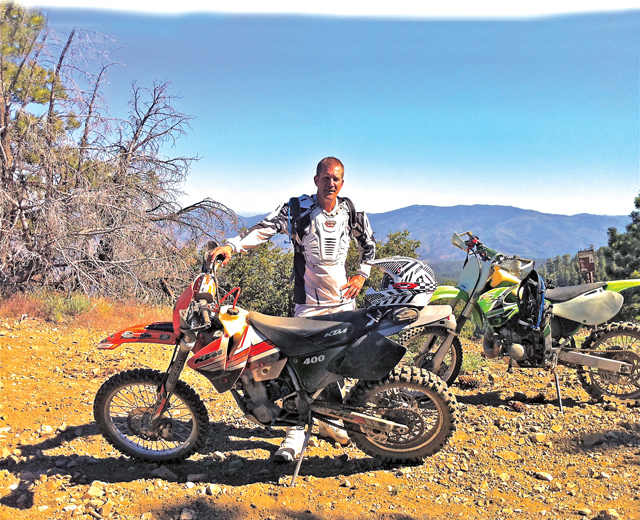Dirt-Bike Hippie
One 40-Year-Old Man Finally Realizes His Childhood Fantasy

When I was a grom of about 9, my mom and I would drive north to visit my grandparents in San Francisco. Staring out the window, I’d imagine hurdling along on a motorcycle on the ranch roads and cow trails at freeway speeds, performing uncanny feats of impossibility as if I were Evel Knievel or Steve McQueen.
But it wasn’t until 31 years later that I sat on my first dirt bike. I was hooked.
Dirt biking is like going to Disneyland for adults. I don’t know why I didn’t start sooner. It may be that my parents were hippies, but bikes are also expensive and require religious maintenance. It’s an incredible sport, and while the average user isn’t exactly a cover model for Men’s Health, the top contenders are world-class athletes. There are countless places to ride, from nearby trails around Divide Peak to the off-road parks of Gorman near Interstate 5, Ballinger Canyon off Highway 33, and the northern granddaddy of Hollister Hills, boasting roughly 90 miles of one-way tracks. For me, though, the desert is what really defines off-road riding.
My first trip to the Mojave was in May 2011, where I found nearly limitless riding, hindered only by private property, abandoned mines, and the endangered desert tortoise, which is the major reason why conservationists fight against expansion or even continued use of off-road vehicles there. That makes veteran riders piss and moan that California leads the way on regulating riding, but that’s mostly in the form of official websites requesting that you remain on the established trails. To some, “established trail” means whichever direction you choose, although I’ve found that most riders are relatively conservative in selecting routes, if only because the well-traveled way is much easier to flow on than pioneering a new path into a ditch.
To get to a designated riding area, you’ll need a trailer, truck, and crew, because riding alone is dangerous and boring. Last October, after adopting a family — or was it vice-versa? — who recently acquired a toy hauler, we strapped the bikes inside and journeyed up north to Hollister Hills, where we camped on the knoll of a long, flattened ridgeline. I quickly learned that weekend dirt biking, where campers mix with day-trekkers, is a complete madhouse: Everybody rages along, showcasing the decibel level of their various vehicles.
But then came Sunday. Hollister has a strict sundown rule, when all vehicles must be in camp or on their way home. By 8 p.m., the entire valley was emptied of all but about three campsites. The silence was deafening. This continued until about 9:30 a.m. Monday, when someone broke the truce with his first rev, and then came the audible onslaught.
For the uninitiated, there are two types of bikes — two-stroke (oil/gas mix) and four-stroke (regular gas) — some are off-road-only and others, called dual-sports, are street-legal, too, and there’s also a sticker system: Green-sticker bikes can be ridden year-round, but red stickers come with seasonal and geographic restrictions. Safety is also an obvious consideration, especially the first time you straddle that freaky thing with two wheels and massive engine between your legs, controlled by a mere flick of your wrist. Thanks to the cornucopia of required gear, there’s no reason you should get hurt, unless you ride outside of your comfort zone. That said, falling on a dirt bike is not a matter of if, but when.
Though a class unto itself, dirt biking is similar to mountain biking except that you go uphill as fast as you want. It’s also like snow sports, considering the gear, the need for a designated riding area, and the long journey to get there. Unlike surfing, where the locals wish newbies would shrivel up and die, the community of dirt bikers, with very few exceptions, is like one extended family.
It’s like being a kid all over again.



